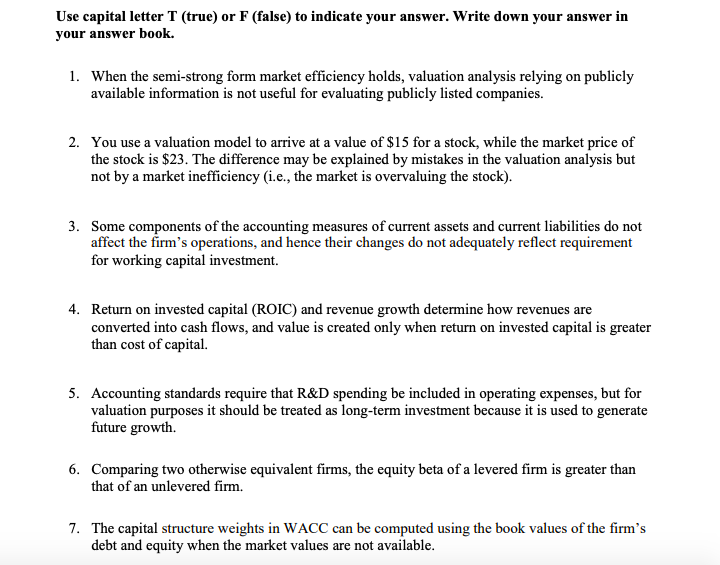


Use capital letter T (true) or F (false) to indicate your answer. Write down your answer in your answer book. Use capital letter T (true) or F (false) to indicate your answer. Write down your answer in your answer book. 1. When the semi-strong form market efficiency holds, valuation analysis relying on publicly available information is not useful for evaluating publicly listed companies. 2. You use a valuation model to arrive at a value of $15 for a stock, while the market price of the stock is $23. The difference may be explained by mistakes in the valuation analysis but not by a market inefficiency (i.e., the market is overvaluing the stock). 3. Some components of the accounting measures of current assets and current liabilities do not affect the firm's operations, and hence their changes do not adequately reflect requirement for working capital investment. 4. Return on invested capital (ROIC) and revenue growth determine how revenues are converted into cash flows, and value is created only when return on invested capital is greater than cost of capital. 5. Accounting standards require that R&D spending be included in operating expenses, but for valuation purposes it should be treated as long-term investment because it is used to generate future growth. 6. Comparing two otherwise equivalent firms, the equity beta of a levered firm is greater than that of an unlevered firm. 7. The capital structure weights in WACC can be computed using the book values of the firm's debt and equity when the market values are not available. 8. To use the CAPM to estimate the cost of equity, we determine the expected market risk premium and equity beta using historical return data. One major disadvantage of this approach is that both can change significantly over time and using the past to predict the future is not always reliable. 9. DCF valuation might be difficult to do for a biotechnology firm with no current products or sales but with several promising product patents in the pipeline, because the firm has no history of earnings and cash flow growth, and estimating near-term cash flows may be impossible. 10. The terminal value in a DCF valuation analysis is often computed using the constant growth model, where the perpetual growth rate can be determined based on the firm's historical growth over a sufficiently long period. Use capital letter T (true) or F (false) to indicate your answer. Write down your answer in your answer book. Use capital letter T (true) or F (false) to indicate your answer. Write down your answer in your answer book. 1. When the semi-strong form market efficiency holds, valuation analysis relying on publicly available information is not useful for evaluating publicly listed companies. 2. You use a valuation model to arrive at a value of $15 for a stock, while the market price of the stock is $23. The difference may be explained by mistakes in the valuation analysis but not by a market inefficiency (i.e., the market is overvaluing the stock). 3. Some components of the accounting measures of current assets and current liabilities do not affect the firm's operations, and hence their changes do not adequately reflect requirement for working capital investment. 4. Return on invested capital (ROIC) and revenue growth determine how revenues are converted into cash flows, and value is created only when return on invested capital is greater than cost of capital. 5. Accounting standards require that R&D spending be included in operating expenses, but for valuation purposes it should be treated as long-term investment because it is used to generate future growth. 6. Comparing two otherwise equivalent firms, the equity beta of a levered firm is greater than that of an unlevered firm. 7. The capital structure weights in WACC can be computed using the book values of the firm's debt and equity when the market values are not available. 8. To use the CAPM to estimate the cost of equity, we determine the expected market risk premium and equity beta using historical return data. One major disadvantage of this approach is that both can change significantly over time and using the past to predict the future is not always reliable. 9. DCF valuation might be difficult to do for a biotechnology firm with no current products or sales but with several promising product patents in the pipeline, because the firm has no history of earnings and cash flow growth, and estimating near-term cash flows may be impossible. 10. The terminal value in a DCF valuation analysis is often computed using the constant growth model, where the perpetual growth rate can be determined based on the firm's historical growth over a sufficiently long period









